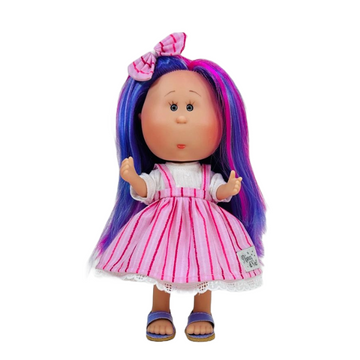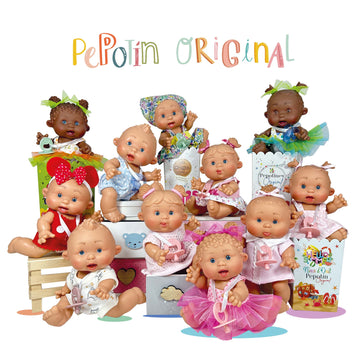9 Easy Facts About Dolls And Accessories Shown
9 Easy Facts About Dolls And Accessories Shown
Blog Article
The 5-Minute Rule for Dolls And Accessories
Table of ContentsThings about Dolls And AccessoriesMore About Dolls And AccessoriesDolls And Accessories Can Be Fun For Anyone7 Simple Techniques For Dolls And AccessoriesThe Ultimate Guide To Dolls And AccessoriesThe Facts About Dolls And Accessories RevealedFascination About Dolls And Accessories
When dolls are included in group play, kids exercise waiting, sharing, and paying attention to others' ideas. Whether they're pretending to be a moms and dad, sibling, or buddy, kids discover just how partnerships workhow to support others, solve disagreements, and look after a person else. These very early role-play experiences end up being the foundation for healthy friendships and connections later in life.Duplicating soothing regimens with a doll (feeding, rocking, putting to bed) can aid kids feel tranquil and protected. These comforting routines show them just how to self-regulate. Taking treatment of a doll can make a kid really feel qualified and confident - baby dolls. It provides a feeling of responsibility and control in a world that commonly feels uncertain.
Getting The Dolls And Accessories To Work
When youngsters see dolls that show their race, heritage, and society, it reinforces a favorable feeling of identification. Dolls additionally present kids to cultures outside their own, constructing considerate curiosity and empathy for others.
As Dr. Karyn Purvis, a leader in youngster growth and trauma-informed care, once said: This powerful quote highlights how play isn't simply funit's exactly how children find out finest. The brain cords itself via rep. However when a youngster is engaged, cheerful, and emotionally connected to an activitylike doll playthe mind reinforces those connections quicker and a lot more meaningfully.
Things about Dolls And Accessories

Boys require empathy, kindness, and creativity tooand doll play uses that. Yesdolls use something distinct. They encourage flexible storytelling and emotional connection in a manner couple of other playthings do. Dolls are often a kid's first "friend," assisting them practice connections, build interaction skills, and feel comforted. Youngsters establish their sense of self from a young age.
How Dolls And Accessories can Save You Time, Stress, and Money.
Via play. Through satisfaction. Through dolls that matter. Thanks for joining us on this journey. Samantha Ong Samantha Ong is the owner of Joeydolls, a Canadian-based toy brand on a mission to celebrate Asian cultures with joyous, comprehensive play. Influenced by her own experiences maturing without social depiction, Samantha designs dolls that help kids really feel happy with that they are while stimulating interest and compassion in others.
Playing with dolls encourages kids to talk even more regarding others' thoughts and emotions, a study has discovered. The research suggests that playing Go Here fictional games with dolls might help youngsters establish social skills, theory of mind and compassion.
About Dolls And Accessories
They were likewise most likely to resolve the dolls in the 2nd person, chatting to them directly, whereas the characters on the computer display they often tended to refer to in the 3rd person. No distinction was observed in between young boys and ladies."Internal state language can indicate that a kid is considering other people's ideas and emotions while playing with dolls," said Gerson.
And that they see language usage in this regard is good confirmation of the hypothesis."Mardell included that the searchings for ought to use to any kind of kind of role-play plaything, instead than being details to Barbies."Children normally start to show signs of inner state language around the age of four.
The Dolls And Accessories Diaries
"It comes to be important for making and maintaining relationships, and just how they pick up from their instructors, and parents."The study also located that the youngsters had actually boosted brain activity in the posterior exceptional temporal sulcus (pSTS) area when they talked as though their dolls had thoughts and feelings. The pSTS area is believed to be involved in the development of social and emotional processing abilities.
Youth is not a fixed life phase; certainly, the meaning, significance and understanding of childhood are all based on alteration. By the 19th century one of the most extensive adjustments was the importance placed on enabling kids to experience "the carefree delights" of childhood years through play tasks. Play was currently taken into consideration to be an important component of an excellent childhood.
In order to fully comprehend the meaning of play, one must also recognize the relevance of the doll. Dolls are a lot more than playthings designed to entertain young women. During the nineteenth century appropriate playtime activities were picked to promote intellectual, physical or psychological growth. Dolls were especially popular because they were believed to cultivate and support feminine top qualities such as compassion, caring and concern.
The Best Guide To Dolls And Accessories

It is just with historical investigations that scientists can wish to discover and record the full variety of playtime experiences. Narrating these experiences, and specifically the function of dolls, is essential for offering a much more complete image of youth throughout the nineteenth century. Alarcn, Sara E - doll accessories., "Kid's Play: The Duty of Dolls in 19th Century Childhood Years" (2007 )
Report this page